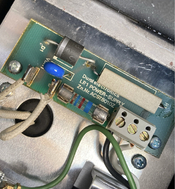Welcome to Photrio!
First, check if the head is rated for 110V. If not, use a step-up transformer - but I expect it's intended for 110V operation and that voltage 'regulation' down to the probably ca. 100V is accomplished by a series dropping resistor (the grey box above the screw connectors).
I'd start by measuring continuity of the wiring and inspecting the bulb socket for loose/bad connections and corrosion. Especially the latter is often a concern. Measure the resistor to verify it shows a sensible resistance; I'd expect this to be a few ohms or so. The diode should measure ca. 0.7 forward voltage when measured with a multimeter in its diode measurement setting. The fuse looks OK, but check continuity. Measure the resistance between both leads of the blue round part (which is likely a MOV/varistor); without the bulb installed, this should be very high (several dozens of kOhms or more).
Also measure the bulb for continuity to ensure you're not working with a broken bulb.
The next step would be to measure the voltage on the socket with the enlarger plugged in, but without a bulb. You should measure your grid voltage now. If so, unplug the enlarger, install a bulb and try again.
If your enlarger is intended for 230V and you're attempting to use it with 110V, use a step-down transformer. Alternatively, a thyristor dimmer circuit may work as well and is usually a cheaper solution, but they generally blow at some point and may damage the rudimentary power supply of the enlarger (and it'll blow the bulb). If you don't want to risk this, use a step down transformer, which is generally the most reliable approach. Or find an enlarger + bulb rated for your grid voltage.












